



Herbalism & Historical Responsibility Emily Beck, Ph.D., & Macey Flood, MA North Country Herbalist Guild, 4 November 2020
Wangensteen Historical Library, circa 1965
Scattered logs floating down the river, c. 1880. Photograph, Minnesota Historical Society.
3 Seasons of Herbal Wisdom students in the Wangensteen, reading historical books & giving short presentations on them. 2016.
Presentation overview : 1. History of herbal medicine in the “academy” 2. Why we think herbalists should be involved in creating academic histories 3. What history can ofger to modern herbal practitioners 4. Current activities & resources
Plants and Empire by Londa Schiebinger, A Not-So-New World by Christopher Parsons, and Drugs on the Page , ed. Crawford & Gabriel
Nature’s Path by Susan Cayleff, Trying to Give Ease by John Crellin & Jane Philpott, and Working Cures by Sharla Fett
Ethics
Read more about cotton root bark in “Gossypium spp. (Cotton Root Bark): A Symbol of Herbal Resistance,” Karen L. Culpeper. Journal of the American herbalist Guild 15:2 (2017): 45-52.
Social construction of disease
Sweet Marjoram: “It helps with cold griefs of the womb , and windiness thereof.” Wild Valerian: “It is often given with advantage in hysterical cases .” Vervain: “This is an herb of Venus, and excellent for the womb, to strengthen and remedy all the cold disorders thereof.” Arrach: “I commend it for an universal medicine from the womb… [it will] speedily cure any disease thereof, as the fits of the mother, dislocation, or falling out thereof.” Catmint: “helping the green sickness , and also the suffocation of the womb and vapours.”
Text and context
Frances Densmore, "Uses of plants by the Chippewa Indians," Bureau of American Ethnology Bulletin 44 (1928)
Mary Warren English Frances Densmore Many others contributed to the project from White Earth, Red Lake, Mille Lacs, Cass Lake, Lac Courte Oreilles, and Manitou Rapids Reserve (Ontario).
What is history made from?
Timeline of activities 2015: “The Roots of Western Herbalism” 2017: Presentation to St Catherine Midwest Holistic Health and Herbal University at the Wangensteen as part of Education Conference (third time their Master’s in Holistic Health Studies. presenting, first time on history.) 2018: Community herbal history class. 2015-present: history lectures as part of Three Seasons of Herbs class by Lise Wolf. 2018: LearningLife (Continuing Education) class for University of Minnesota, “Western 2016: Lise & 3 Seasons come to Herbalism: History, Theory, Practice.” Wangensteen. 2018-2019: Herbs and History 2016: North Country Herb Guild come to interdisciplinary reading group. Wangensteen 2019: Community herbal history class.
An Approv’d Receipt for ye Gravel Take of Mallows and March Mallows of Each 1 handfull of ye roots of ye same one Ounce Cut them into Small pieces and boyl them in three pints of Epsom Waters till it is reducd to a quart then strain the liquor and dissolve in it one Ounce and half of Manna and then drink it. (WZ250 A568e 1680)
Open to the public! Only by appointment due to COVID-19 M & Th 8:30-12:30 T & F 12:30-4:30 Email: wanghist@umn.edu Website: z.umn.edu/whl
Digitized materials from the Wangensteen z.umn.edu/DigitalWHL
Digital Public Library of America https://dp.la/
Recommend
More recommend